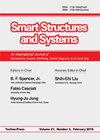一种用于检测挡土墙后面空腔的混合无损检测方法
IF 2.2
3区 工程技术
Q2 ENGINEERING, CIVIL
引用次数: 0
摘要
本研究提出了一种无损检测方法的组合,用于检测挡土墙后面的土壤空洞,这些空洞会对斜坡地面或挡土墙结构的稳定性产生不利影响。使用混凝土墙板保留的干砂填充土壤室进行了实验研究。在墙板后面模拟了一个半球形土腔,并使用加速度计测量了撞击墙壁的弹性波反射。利用时域中的信号能量和频域中的主频和迁移率谱对测量的弹性波进行了分析。此外,在加热和冷却过程中,使用红外热像仪监测墙壁表面的时空变化。然后,所捕获的热图像被用于识别空腔。实验结果表明,空腔使信号能量、主频和迁移率谱的灵活性增加。热图像中的对比度有效地揭示了土壤空洞的形状和位置。这项研究表明,混合测试方法通过弹性波对红外热像仪初步扫描中怀疑的区域进行仔细检查,对于检测土壤空洞来说是有竞争力和有效的。本文章由计算机程序翻译,如有差异,请以英文原文为准。
A hybrid nondestructive testing method for detecting cavities behind the retaining wall
This study proposes a combination of nondestructive testing methods for detecting soil cavities behind retaining walls, which adversely affect the stability of the sloping ground or retaining structures. An experimental study is conducted using a soil chamber filled with dry sands retained by a concrete wall plate. A hemispherical soil cavity is simulated just behind the wall plate, and elastic wave reflections of impacts on the wall are measured using accelerometers. The measured elastic waves are analyzed using the signal energy in time domain and predominant frequency and mobility spectrum in frequency domain. In addition, spatiotemporal changes in the surface of the wall during heating and cooling sequences are monitored using infrared thermography. The captured thermal image is then used for identifying the cavity. Experimental results show that the cavity leads to increases in the signal energy, predominant frequency, and flexibility in the mobility spectrum. The contrasts in the thermal images effectively reveal the shapes and locations of the soil cavity. This study demonstrates that the hybrid testing method that conducts a careful inspection by elastic waves on areas suspected in the preliminary scanning by the infrared thermography can be competitive and effective for detecting soil cavities.
求助全文
通过发布文献求助,成功后即可免费获取论文全文。
去求助
来源期刊

Smart Structures and Systems
工程技术-工程:机械
CiteScore
6.50
自引率
8.60%
发文量
0
审稿时长
9 months
期刊介绍:
An International Journal of Mechatronics, Sensors, Monitoring, Control, Diagnosis, and Management airns at providing a major publication channel for researchers in the general area of smart structures and systems. Typical subjects considered by the journal include:
Sensors/Actuators(Materials/devices/ informatics/networking)
Structural Health Monitoring and Control
Diagnosis/Prognosis
Life Cycle Engineering(planning/design/ maintenance/renewal)
and related areas.
 求助内容:
求助内容: 应助结果提醒方式:
应助结果提醒方式:


